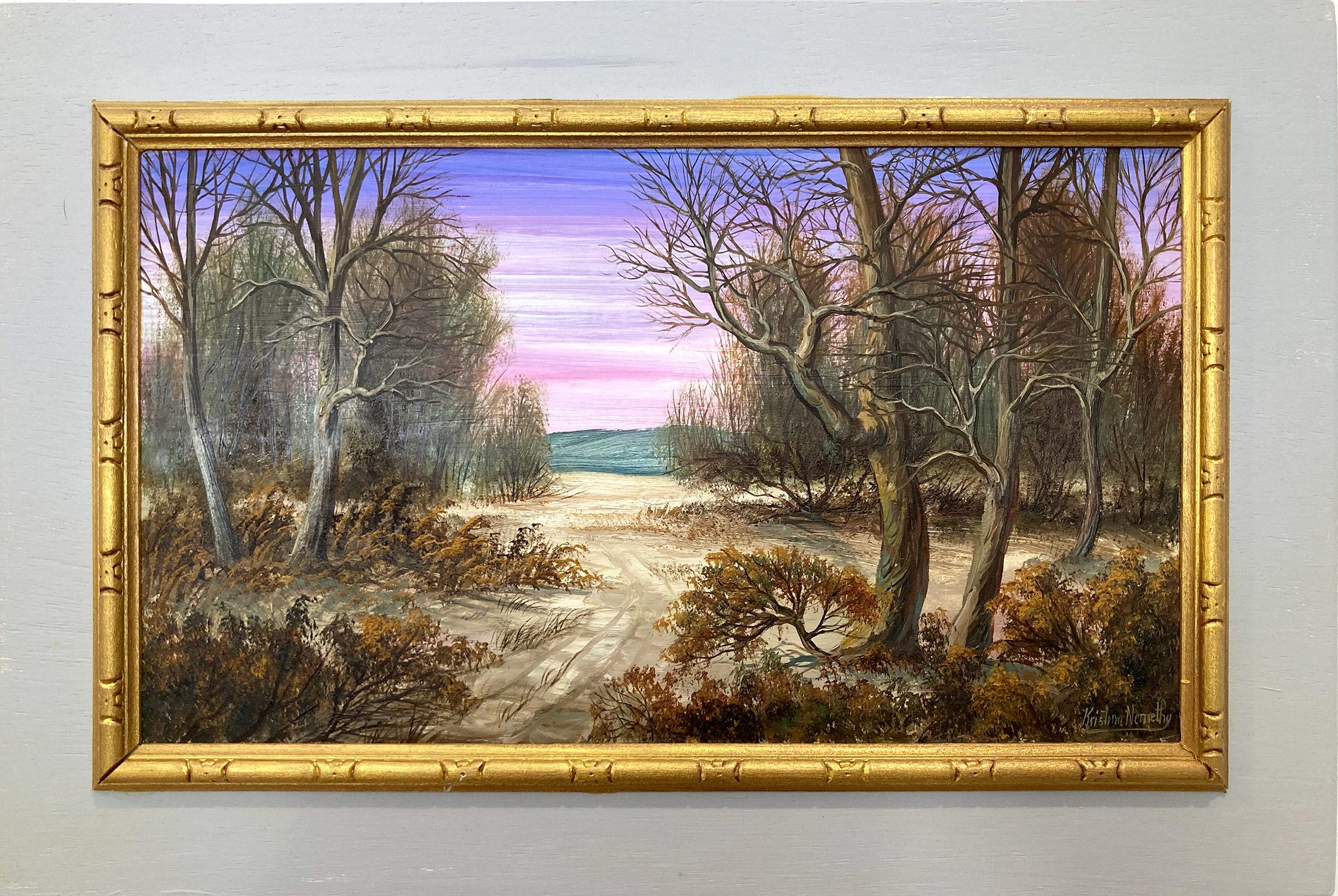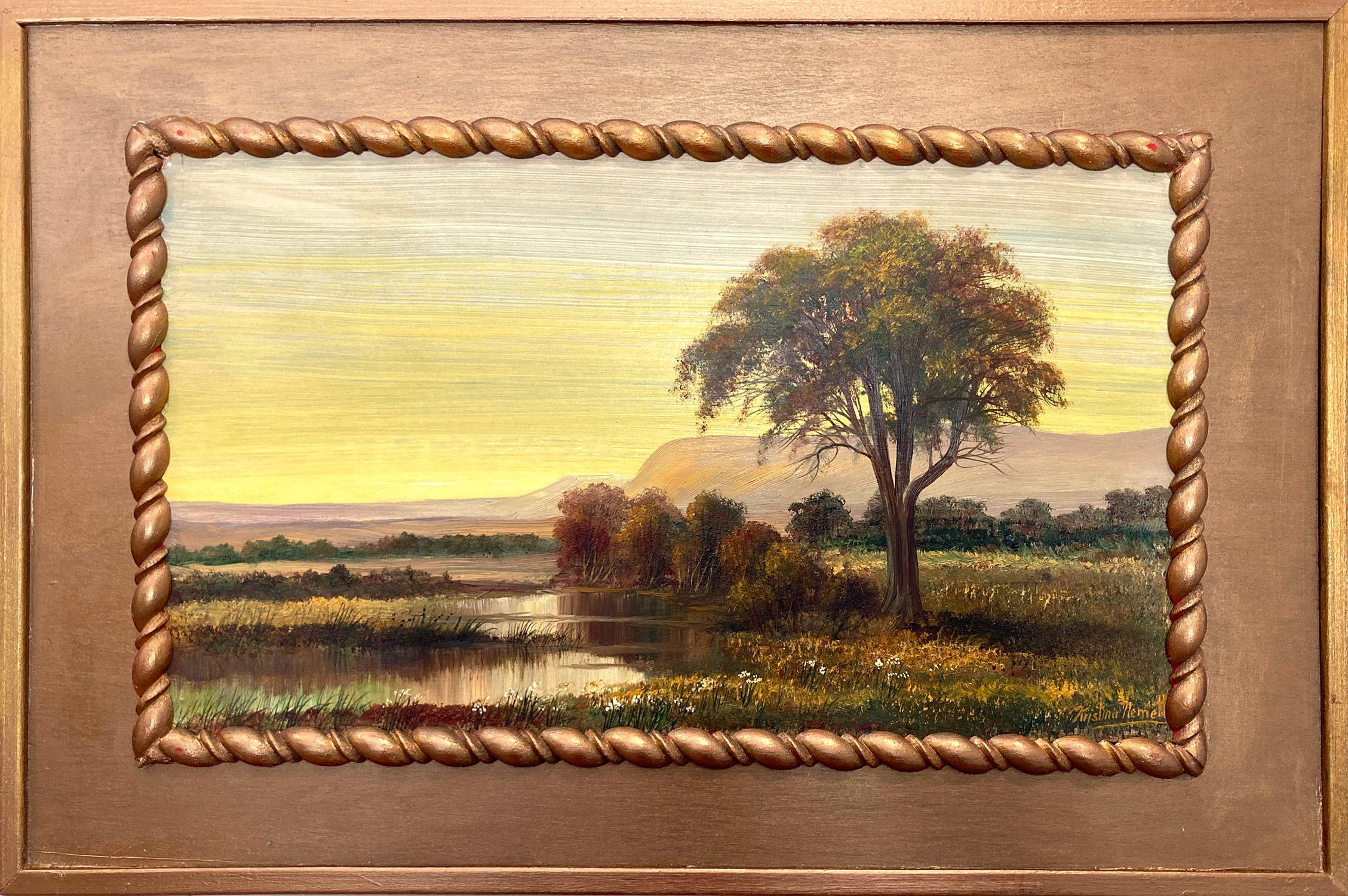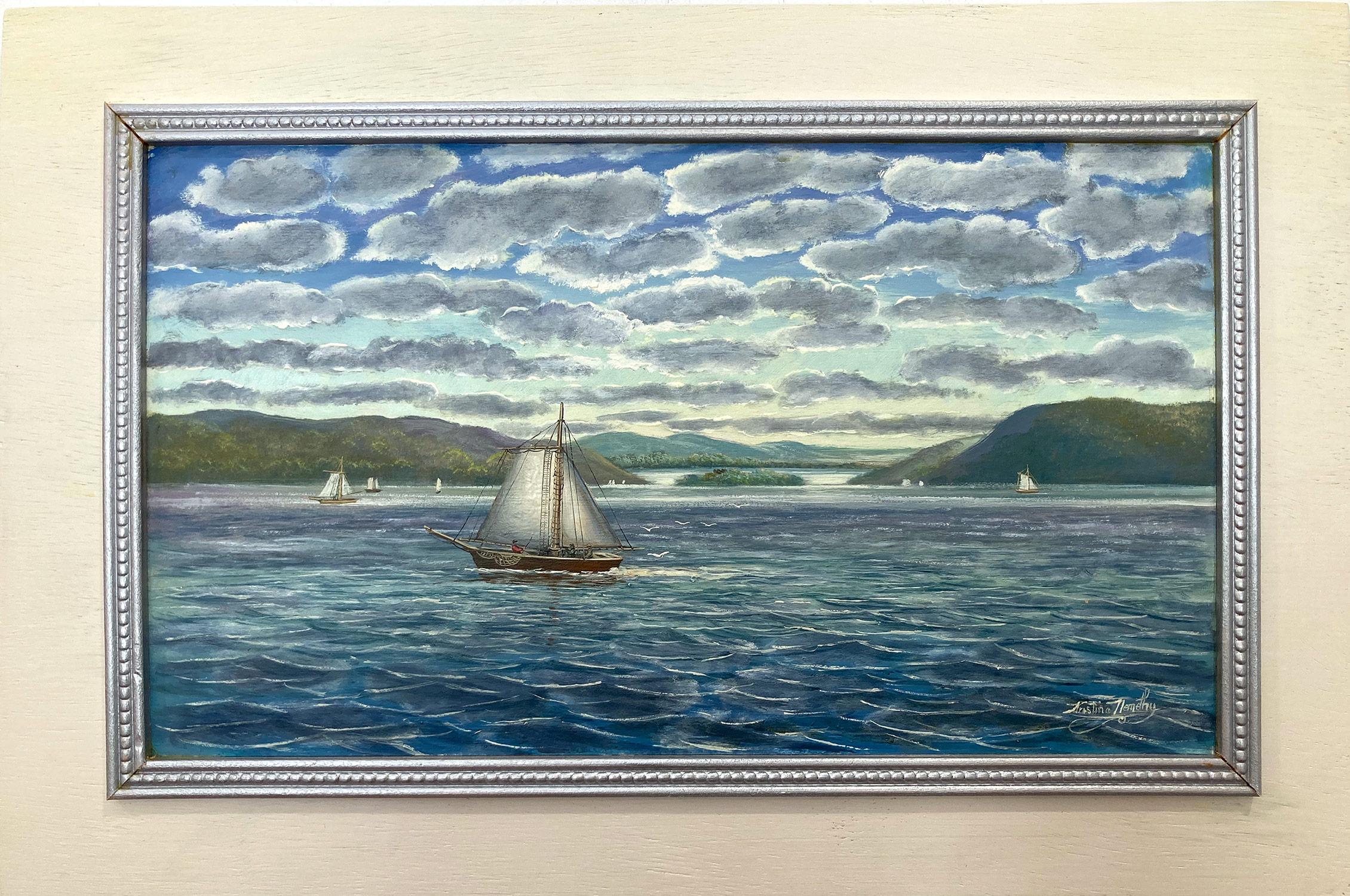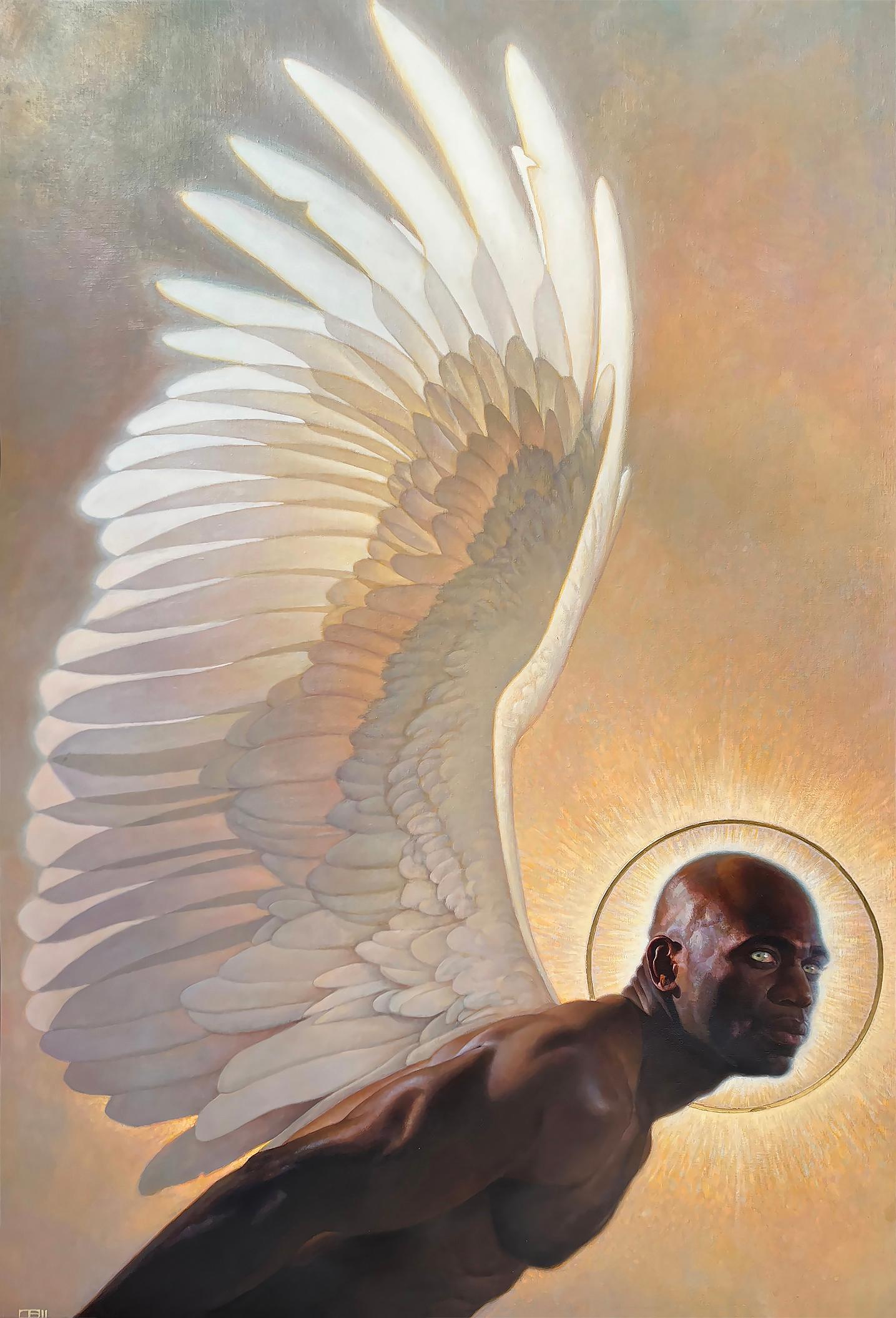Items Similar to His Only Pet
Want more images or videos?
Request additional images or videos from the seller
1 of 5
Charles Caleb Ward His Only Pet 1871
1871
About the Item
Charles Caleb Ward was born in St. John, New Brunswick, Canada, the grandson of a New York Ward who had left for New Brunswick around the time of the Revolutionary War because of loyalist sympathies. The Ward family grew to local prominence there, becoming involved in the shipping and quarrying businesses. As a young man, Charles Caleb Ward was sent to London to learn the family shipping business. Instead, he spent most of his time studying art with the English pre-Raphaelite painter, William Henry Hunt (1790–1864), who was known for his meticulous still lifes often centered on a bird’s nest in a forest setting. After living in London and Paris for several years, Ward moved to New York in 1850, and stayed for a year before leaving the city to travel variously throughout the East, and eventually resettled and married in New Brunswick. Ward returned to New York in 1868, where he maintained a studio at least until 1872. His whereabouts for the next ten years are not known, but it seems likely that he may have remained in New York until the early 1880s.
Ward is known to have been back in Canada by 1881, as when one of his works was included in the National Academy of Design’s annual exhibition in that year, he was recorded as living in New Brunswick. But, this does confirm that Ward maintained a tie to the New York art world even after his return to Canada. Very little is known of his activity after 1881, although a small number of works have surfaced from the late 1880s and 1890s. He died in Rothesay, New Brunswick, in 1896.
Ward’s years in New York were his most active as a professional artist. He exhibited often at New York venues, including the National Academy of Design, the American Society of Painters in Water Colors, the Century Association, and the Brooklyn Art Association. He also sent works to the Union League Club, Philadelphia; the Cincinnati Academy, Ohio; the Utica Art Association, New York; and the Louisville Industrial Exposition, Kentucky.
Though our knowledge today of Ward’s activity and oeuvre is fragmentary, he was held in high esteem in his own time. William H. Gerdts has noted that Ward “was among the finest genre specialists of the mid-century, and one whose work has been somewhat neglected, as much because of its rarity as for any other reason” (19th Century American Painting from the Collection of Henry Melville Fuller, exhib. cat. [Manchester, New Hampshire: Currier Gallery of Art, 1971), p. 9). Indeed, Ward specialized in genre scenes, mostly of children and Native Americans, both in oil and watercolor. Ward was especially renowned for his small-format genre paintings, and it was said of his work that “his pictures were small in size, but so finely and beautifully executed that they would always bear close scrutiny with a powerful glass” (David Russell Jack, Acadiensis VI [1906], p. 97). Although Ward was evidently a prolific artist, few works by him are known. Most are in Canadian collections, though a few are in prominent American museum collections, including the National Gallery of Art, Washington, D.C.; The Metropolitan Museum of Art, New York; the Smith College Museum of Art, Northampton, Massachusetts; the Bowdoin College Museum of Art, Brunswick, Maine; the Mead Art Museum, Amherst College, Amherst, Massachusetts; and the Currier Gallery of Art, Manchester, New Hampshire.
Painted in 1871, His Only Pet hails from Ward’s period of activity in New York. It is one of Ward’s typically small, gem-like genre pieces, and as with many of these the artist manages to combine both a humorous and sentimental subject with a variety of masterful details that subtly enrich the composition. Outside a weathered, stuccoed brick barn, three barefoot urchins discover a dead bird on the ground. A calico cat, having killed the bird, watches the scene coolly from a perch high up on a ladder that hangs on the exterior wall of the barn. Two of the boys kneel down to get a closer look at the bird, marveling at its diminutive, upturned form. The third boy, on the other hand, remains standing and wipes a tear from his face with the back of his hand, having lost his only pet that somehow has escaped its cage. Filling out the composition are a few expertly rendered anecdotal details, including a half-eaten apple, a metal pan, what appears to be a small wooden trap, and other bits of detritus at the left, and a bit of ivy creeping along the white wall at the right.
Beyond the obvious sentiment and humor evidenced in His Only Pet, Ward’s painting of a dead bird takes on an additional layer of meaning by playing artfully on the dead-bird-as-pathos motif that had currency in American art at mid-century. The dead-bird motif was a relatively uncommon in American art at mid-century, but it was particularly seen among the works of the American Pre-Raphaelites, the group of American followers of the truth-to-nature aesthetic of the English critic John Ruskin that was active in the 1860s and 1870s. The still form of a dead songbird was meant to elicit pathos via ruminations on the fragility and delicate beauty of life. Paintings of dead songbirds were common among the Pre-Raphaelites, the best known of them being John Henry Hill’s etching, Black Capped Titmouse, which was published in his Sketches from Nature of 1867 (pl. 7; see Linda S. Ferber and William H. Gerdts, The New Path: Ruskin and the American Pre-Raphaelites, exhib. cat. [New York: The Brooklyn Museum, 1985], p. 171 no. 19 illus.), four years before Ward painted His Only Pet. Other members of the Pre-Raphaelite group known to have painted studies of dead birds include Thomas Charles Farrer and John William Hill; other artists working in a Ruskinian manner, such as Robert Brandegee and Fidelia Bridges, also pursued this theme. While Ward was not likely directly connected to the Pre-Raphaelites, he almost certainly would have been aware of their works in New York exhibitions. Also, Ward’s English master, William Henry Hunt, was a favorite of Ruskin, and Ward’s work evinces the heightened sentiment and meticulous attention to nature that Ruskin called for in his celebrated writings on art.
In His Only Pet, however, Ward cleverly turns this motif on its head. Instead of making the subject of his painting the delicate form of the dead bird, Ward centers the narrative on the childlike and disarmingly direct responses of the children to the figure of the dead bird. The viewer is not asked to reflect philosophically on life and death but on the innocence of childhood.
Ward showed His Only Pet at the Brooklyn Art Association’s annual exhibition in late 1871 along with another genre picture of children, Coming Events Cast Their Shadows Before (1871, The Metropolitan Museum of Art; see Natalie Spassky et al., American Paintings in The Metropolitan Museum of Art, II [New York: The Metropolitan Museum of Art, 1985], p. 336 illus.), which today is Ward’s best-known painting. A reviewer for the Brooklyn Daily Eagle saluted Ward for his accomplishment: “Charles C. Ward is represented by two superb cabinet examples equaling some of the finest foreign pictures in their brilliancy of color and finish. “His Only Pet” shows a trio of children mourning over a dead bird. The attitudes of the little ones are childlike and unaffected” (“Brooklyn Art Association,” Brooklyn Daily Eagle, November 2, 1871, p. 4). Indeed, Ward was esteemed for his paintings of children based entirely on his outstanding ability to capture the very essence of his youthful subjects.
- Creator:Charles Caleb Ward (1831 - 1896)
- Creation Year:1871
- Dimensions:Height: 5.7 in (14.48 cm)Width: 7.9 in (20.07 cm)Depth: 1.5 in (3.81 cm)
- Medium:
- Movement & Style:
- Period:
- Condition:
- Gallery Location:New York, NY
- Reference Number:
About the Seller
5.0
Recognized Seller
These prestigious sellers are industry leaders and represent the highest echelon for item quality and design.
Established in 1952
1stDibs seller since 2010
32 sales on 1stDibs
Typical response time: 7 hours
Associations
Art Dealers Association of America
- ShippingRetrieving quote...Ships From: New York, NY
- Return PolicyThis item cannot be returned.
More From This SellerView All
- Figure in a LandscapeBy David JohnsonLocated in New York, NYSigned (at lower right): DJ [monogram]; (on back): David Johnson 1865Category
Mid-19th Century American Realist Landscape Paintings
MaterialsOil, Board
- Strawberries Strewn on a Forest FloorBy William Mason BrownLocated in New York, NYWilliam Mason Brown was born in Troy, New York, where he studied for several years with local artists, including the leading portraitist there, Abel Buel Moore. In 1850, he moved to ...Category
19th Century American Realist Landscape Paintings
MaterialsCanvas, Oil
- Portrait of the Ship ExcelsiorBy Joseph LeeLocated in New York, NYOil and India ink on canvas, 34 1/4 x 54 1/4 in. Signed (at lower right): Joseph Lee Painted about 1876 EX COLL.: Captain Oscar Conrad Kustel (1834–1921), ...Category
Late 19th Century American Realist Landscape Paintings
MaterialsIndia Ink, Oil
- Saint-Malo, BrittanyBy William Stanley HaseltineLocated in New York, NYThe career of William Stanley Haseltine spans the entire second half of the nineteenth century. During these years he witnessed the growth and decline of American landscape painting, the new concept of plein-air painting practiced by the Barbizon artists, and the revolutionary techniques of the French Impressionists, all of which had profound effects on the development of painting in the western world. Haseltine remained open to these new developments, selecting aspects of each and assimilating them into his work. What remained constant was his love of nature and his skill at rendering exactly what he saw. His views, at once precise and poetic, are, in effect, portraits of the many places he visited and the landscapes he loved. Haseltine was born in Philadelphia, the son of a prosperous businessman. In 1850, at the age of fifteen, he began his art studies with Paul Weber, a German artist who had settled in Philadelphia two years earlier. From Weber, Haseltine learned about Romanticism and the meticulous draftsmanship that characterized the German School. At the same time, Haseltine enrolled at the University of Pennsylvania, and took sketching trips around the Pennsylvania countryside, exploring areas along the Delaware and Susquehanna rivers. Following his sophomore year, Haseltine transferred to Harvard University. After graduating from Harvard in 1854, Haseltine returned to Philadelphia and resumed his studies with Weber. Although Weber encouraged Haseltine to continue his training in Europe, the elder Haseltine was reluctant to encourage his son to pursue a career as an artist. During the next year, Haseltine took various sketching trips along the Hudson River and produced a number of pictures, some of which were exhibited at the Pennsylvania Academy of the Fine Arts in the spring of 1855. Ultimately, having convinced his father that he should be allowed to study in Europe, Haseltine accompanied Weber to Düsseldorf. The Düsseldorf Academy was, during the 1850s, at the peak of its popularity among American artists. The Academy’s strict course of study emphasized the importance of accurate draftsmanship and a strong sense of professionalism. Landscape painting was the dominant department at the Düsseldorf Academy during this period, and the most famous landscape painter there was Andreas Achenbach, under whom Haseltine studied. Achenbach’s realistic style stressed close observation of form and detail, and reinforced much of what Haseltine had already learned. His Düsseldorf training remained an important influence on him for the rest of his life. At Düsseldorf, Haseltine became friendly with other American artists studying there, especially Emanuel Leutze, Worthington Whittredge, and Albert Bierstadt. They were constant companions, and in the spring and summer months took sketching trips together. In the summer of 1856 the group took a tour of the Rhine, Ahr, and Nahe valleys, continuing through the Swiss alps and over the Saint Gotthard Pass into northern Italy. The following summer Haseltine, Whittredge, and the painter John Irving returned to Switzerland and Italy, and this time continued on to Rome. Rome was a fertile ground for artists at mid-century. When Haseltine arrived in the fall of 1857, the American sculptors Harriet Hosmer, Chauncey B. Ives, Joseph Mozier, William Henry Rinehart...Category
19th Century American Realist Landscape Paintings
MaterialsCanvas, Oil
- Golden Rod and other WildflowersBy John Ross KeyLocated in New York, NYSigned (at lower right): John Ross Key 1882Category
Late 19th Century American Realist Still-life Paintings
MaterialsCanvas, Oil
- Street Scene: "King George Dies"By Thomas FransioliLocated in New York, NYFransioli was born in Seattle, Washington, and received a degree in architecture from the University of Pennsylvania in 1930. He worked with John Russell Pope on plans for the exhibition galleries at the National Gallery of Art in Washington, D.C., which he pinpointed as the beginning of his interest in painting. World War II interrupted a promising career in architecture. Fransioli served in the Pacific Theatre from 1943 until 1946, and was among the first American soldiers to survey Hiroshima after the atomic bomb’s detonation in August 1945. He returned to civilian life and took up painting, basing himself in Boston, but working up and down the eastern seaboard. Thomas Fransioli’s cityscapes are crisp and tidy. Buildings stand in bold outline, their forms squarely defined by stark light and long shadows. Saturated color permeates every corner of his canvases, from vibrant oranges and greens to smoky terra cottas and granites. Even the trees that line Fransioli’s streets, parks, and squares are sharp and angular, exactly like those in an architect’s elevation rendering. But Fransioli’s cities often lack one critical feature: people. His streets are largely deserted, save for parked cars and an occasional black cat scurrying across the pavement. People make rare appearances in Fransioli’s compositions, and never does the entropy of a crowd overwhelm their prevailing sense of order and precision. People are implied in a Fransioli painting, but their physical presence would detract from the scene’s bleak and surreal beauty. Magic Realism neatly characterizes Fransioli’s artistic viewpoint. The term was first broadly applied to contemporary American art in the 1943 Museum of Modern Art exhibition, American Realists and Magic Realists. As exhibition curator Dorothy Miller noted in her foreword to the catalogue, Magic Realism was a “widespread but not yet generally recognized trend in contemporary American art…. It is limited, in the main, to pictures of sharp focus and precise representation, whether the subject has been observed in the outer world—realism, or contrived by the imagination—magic realism.” In his introductory essay, Lincoln Kirstein took the concept a step further: “Magic realists try to convince us that extraordinary things are possible simply by painting them as if they existed.” This is Fransioli, in a nutshell. His cityscapes exist in time and space, but certainly not in the manner in which he portrays them. Fransioli—and other Magic Realists of his time—was also the heir to Precisionism, spawned from Cubism and Futurism after the Great War and popularized in the 1920s and early 1930s. While Fransioli may not have aspired to celebrate the Machine Age, heavy industry, and skyscrapers in the same manner as Charles Sheeler, his compositions tap into the same rigid gridwork of the urban landscape that was first codified by the Precisionists. During the 1950s, Fransioli was represented by the progressive Margaret Brown...Category
20th Century American Realist Paintings
MaterialsCanvas, Oil
You May Also Like
- "Autumn Season Wetlands" Dreamy American Oil Painting Landscape on BoardBy Kristina NemethyLocated in New York, NYA fine depiction of an autumn season landscape of Wetlands with a beautiful reflection of sunlight hitting the water. For this wonderful depiction, Nemethy uses a fine technique whic...Category
2010s American Realist Landscape Paintings
MaterialsOil, Board
- "Sailing on the Hudson River" American Oil Painting on Board of Ships at SeaBy Kristina NemethyLocated in New York, NYA Fine depiction of a Sailing Ship in the Hudson River. For this wonderful depiction, Nemethy uses a Fine technique which depicts the figures on the boat in a miniature way. With joyful colors, this piece is bright and peaceful. This painting is signed by the artist lower left and it comes comes housed in a beautiful simple wood frame and ready to be displayed with hanging wire on verso. This painting measures 8 x 14 inches Framed measures 13 x 19 inches PROVENANCE: Lilac Gallery...Category
Early 2000s American Realist Landscape Paintings
MaterialsOil, Board
- "Path in Woods at the Palisade MT" American Oil Painting Landscape on BoardBy Kristina NemethyLocated in New York, NYA fine depiction of a winter season by Palisade Mountain during twilight. For this wonderful depiction, Nemethy uses a fine technique which depicts the landscape and the pathway in a...Category
2010s American Realist Landscape Paintings
MaterialsOil, Board
- "Rowing on the Lake" American Oil Painting on Board of Figures on the LakeBy Kristina NemethyLocated in New York, NYA Fine depiction of a rowboat with figures on the lake. For this wonderful depiction, Nemethy uses a Fine technique which depicts the figures in a miniature way. With joyful colors, this piece is bright and peaceful. This painting is signed by the artist lower right and it comes comes housed in a beautiful simple wood frame and ready to be displayed with hanging wire on verso. This painting measures 8 x 14 inches Framed measures 13 x 19 inches PROVENANCE: Lilac Gallery...Category
Early 2000s American Realist Landscape Paintings
MaterialsOil, Board
- Black Angel - African American ArtistLocated in Miami, FLThis powerful and graphically composed image of a black man with white angel wings was painted in a realist style by African American artist ...Category
Early 2000s American Realist Portrait Paintings
MaterialsCanvas, Oil, Board
- Frozen Winter Wonderland by American Artist Francis DixonLocated in Larchmont, NYFrancis Dixon (American, 1879-1967) Untitled (Winter Landscape), 20th Century Oil on canvas 12 1/4 x 16 in. Framed: 18 5/8 x 22 1/4 x 1 1/2 in. Signed lower right: Francis Dixon Thi...Category
20th Century American Realist Landscape Paintings
MaterialsOil, Board
Recently Viewed
View AllMore Ways To Browse
Members Only
Midcentury Antiques
Revolutionary Paintings
Antique Finish Painting
Native American War Art
Kentucky Painting
Art Four Antiques
Charles Littler
New Brunswick
Louisville Paintings
Oil Painting Pets
Painting Pre War
Henry Hill
Little Boy Art
Charles Bear
Canada Native American Art
Charles Close Oil Paintings
Antique Pets





